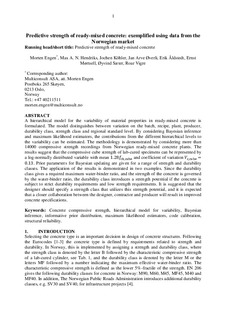Predictive strength of ready-mixed concrete: Exemplified using data from the Norwegian market
Engen, Morten; Hendriks, Max; Kohler, Jochen; Øverli, Jan Arve; Åldstedt, Erik; Mørtsell, Ernst; Sæter, Øystein; Vigre, R
Journal article, Peer reviewed
Accepted version
Permanent lenke
http://hdl.handle.net/11250/2582223Utgivelsesdato
2018Metadata
Vis full innførselSamlinger
Sammendrag
A hierarchical model for the variability of material properties in ready‐mixed concrete is formulated. The model distinguishes between variation on the batch, recipe, plant, producer, durability class, strength class, and regional standard level. By considering Bayesian inference and maximum likelihood estimators, the contributions from the different hierarchical levels to the variability can be estimated. The methodology is demonstrated by considering more than 14,000 compressive strength recordings from Norwegian ready‐mixed concrete plants. The results suggest that the compressive cube strength of lab‐cured specimens can be represented by a log‐normally distributed variable with mean 1.28fck,cube and coefficient of variation Vc,cube=0.13. Prior parameters for Bayesian updating are given for a range of strength and durability classes. The application of the results is demonstrated in two examples. Since the durability class gives a required maximum water–binder ratio, and the strength of the concrete is governed by the water–binder ratio, the durability class introduces a strength potential if the concrete is subject to strict durability requirements and low‐strength requirements. It is suggested that the designer should specify a strength class that utilizes this strength potential, and it is expected that a closer collaboration between the designer, contractor, and producer will result in improved concrete specifications.
